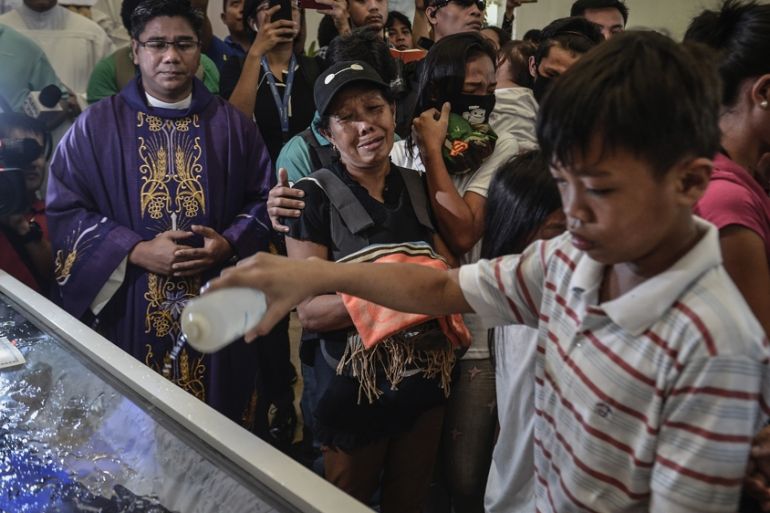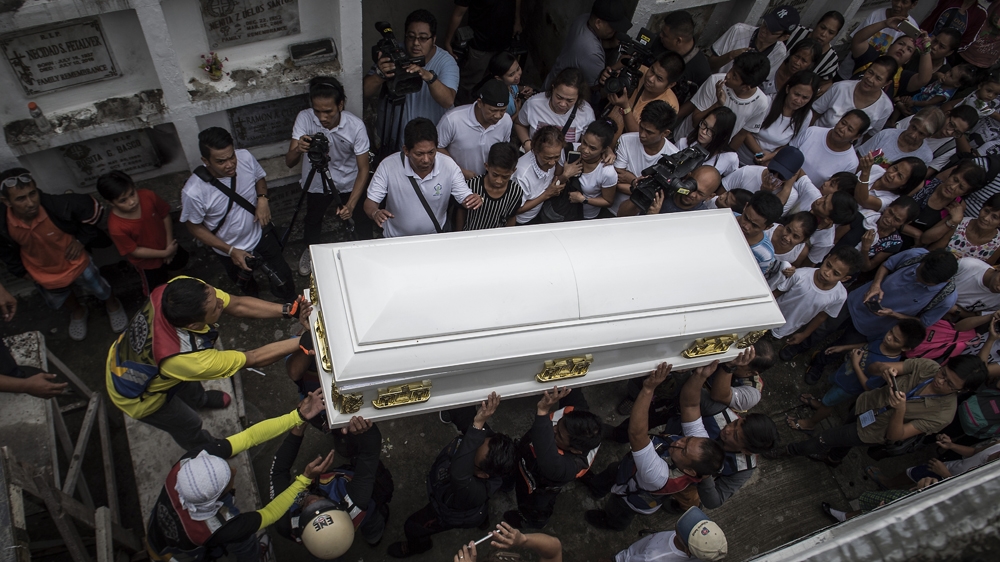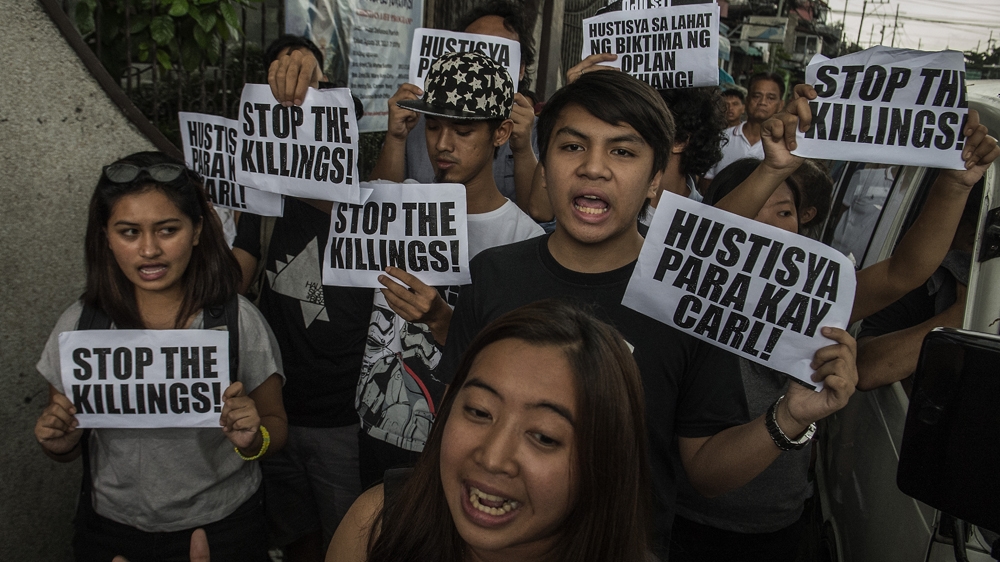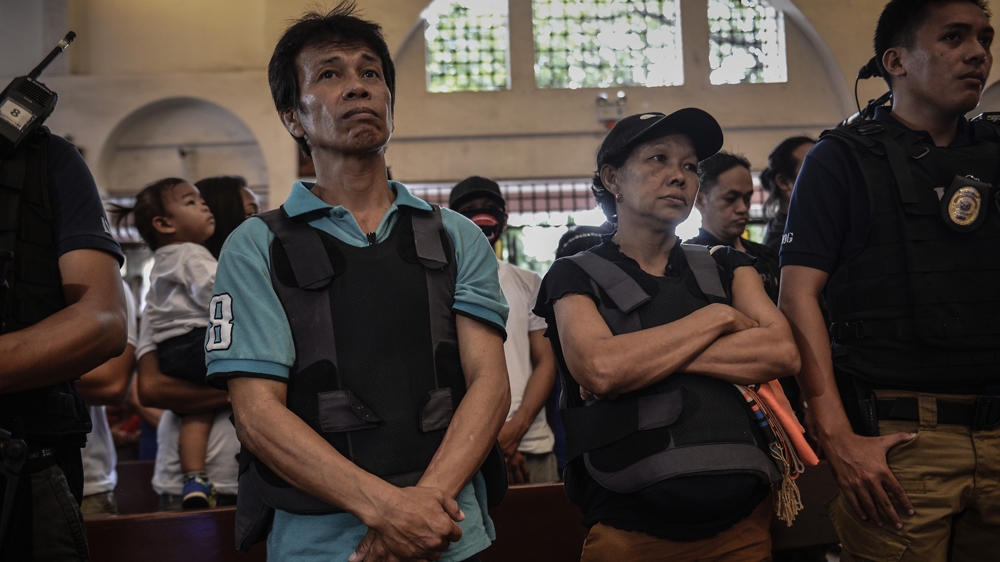The Philippines: when the police kill children
The story of Kulot, one of the many teenagers suspected to have been killed as part of President Duterte’s war on drugs.

Manila, Philippines – His parents named him Reynaldo de Guzman, but everyone knew him as Kulot (Curly) on account of his hair.
Kulot grew up in Anak Pawis (Child of Sweat), a district by the banks of Manila’s largest floodway.
Keep reading
list of 4 itemsPhilippine human rights campaigner granted bail
Families urge Philippines to work with ICC on ‘drug war’ probe
Philippine police officer jailed for killing teens in ‘drug war’
Here, homes made of cardboard and bamboo vie for space with partially constructed concrete apartments.
During the rainy season, the debris-filled floodway overflows, leaving the neighbourhood’s houses under water.
But just a drizzle is enough to stir the stench from the nearby sewers.
Kulot lived with his parents and two of his four siblings in a one-room home where tattered tarp and chicken wire covered the only window.
On school days, he and his younger brother would rise before the sun to begin their two-kilometre walk to school, a place where classmates often teased him for being older and bigger than them and where the brothers rarely had money for lunch.
After school, Kulot would earn less than a cent and a free meal for hauling buckets of fish for sale around the neighbourhood.
On the weekends, he mixed cement or loaded sand and gravel at nearby building sites, handing over almost all his earnings to his mother.
Neighbours remember him as everyone’s favourite errand boy.
Then, in mid-August, Kulot went missing. He was 14 years old.
|
|
Eighteen days later, his body was found 100km from his home, in a creek called Kinamatayang Kabayo (A Horse’s Deathplace).
His face was wrapped in plastic and bound with tape.
Police say his body bore signs of torture and at least 26 stab wounds, many inflicted after he died, some so deep they pierced his heart and lungs.
At the time of his death, the Philippines was already reeling from the murders of several teenagers suspected to have been killed as part of the government’s war on drugs.
According to a Global Post report, as many as 14,000 people may have been killed as part of President Rodrigo Duterte‘s drug war since he took office in 2016.
The Duterte administration has disputed these numbers, claiming that 3,451 “drug personalities” were killed during police operations from June 30, 2016, to July 26, 2017.
It describes more than 2,000 other cases as drug-related homicides by unknown assailants, while at least 8,200 other killings remain “under investigation”.
Of that number, dozens are believed to be teenagers or children.
Human rights organisations, activists and opposition politicians say Duterte has given the police a free pass to sidestep the law and carry out killings without fear of prosecution – allegations his administration and the country’s police force have repeatedly denied.
![Eighteen days after he went missing, Kulot's body was found 100km north of Manila [Ezra Acayan/Al Jazeera]](/wp-content/uploads/2017/11/63e08ab33e454babb7caae80fd01a59f_18.jpeg)
One neighbourhood, two dead boys
Kulot’s relatives and neighbours insist he was not involved in drugs.
The news of his death dealt a second blow to a neighbourhood that was already in mourning.
The day before Kulot’s body was found, the community had buried 19-year-old Carl Angelo Arnaiz, a friend of Kulot’s and the last person he was seen with.
The police say the honour student was killed in a shoot-out after he tried to rob a taxi driver. But his death was later classified as murder by government prosecutors.
Carl and Kulot went missing on the same mid-August night the police launched a major drug war operation across Manila and its suburbs. It left at least 80 people dead in the space of three days.
Relatives and neighbours say the two friends went out for midnight snacks, but never returned.
![Carl Arnaiz, a 19-year-old honour student, was among the dozens of children and teenagers killed in Duterte's drug war [Ezra Acayan/Al Jazeera]](/wp-content/uploads/2017/11/9c9bec1c7d804b8180c26e0ebfa25580_18.jpeg)
At around the time Carl and Kulot disappeared, the attention of the country’s news media was on the death of another teenager, 17-year-old Kian delos Santos, who was killed during a drug raid in the Manila district of Caloocan.
A closed-circuit camera captured the moments before Kian’s death.
In the grainy video, Kian was shown being dragged by officers, contradicting a police report that claimed the Grade 11 student had tried to engage them in a gunfight.
Kian’s bullet-ridden body was later found in a pigsty. When forensic evidence revealed that he had been executed while on the ground, a nationwide outcry ensued.
Murder charges were filed against three police officers.
As the news of what had happened to Kian emerged, Carl’s family grew ever more frantic in their search for him.
They pleaded for help on social media and his mother, who was working as a housekeeper in Dubai, rushed home to join the search.
Ten days after he disappeared, his body was found in a morgue in Caloocan. He had five bullet wounds to his chest and stomach.
Questions began to circulate within the community and the media. How had his body ended up 20km away from his home, they asked. Were the Caloocan police involved?
When two versions of a police report emerged about the attempted robbery police allege Carl was involved in, they seemed to raise more questions than they answered.
![After he went missing, Carl Arnaiz's mother, Eva, returned from Dubai to join the search for her son [Ezra Acayan/Al Jazeera]](/wp-content/uploads/2017/11/c4589af4e10a446b9ab7db3ddf5fd390_18.jpeg)
The taxi driver, Tomas Bagcal, who had been in hiding for 16 days, came forward to say the police had forced him to sign the reports.
He also said that, contrary to what was stated in them, Carl had used a knife, not a gun, during the attempted robbery, and that he wasn’t alone – Kulot was with him.
The police had apprehended Carl and Kulot, he said, and both were alive when they were taken to police headquarters in Caloocan. He had followed the police car to the station, he explained.
Bagcal later told a Senate hearing that after police interrogated Carl and Kulot at the station, the two boys were taken to an unlit area beside a Caloocan highway, where two police officers shot and killed Carl, who was handcuffed and kneeling on the ground – testimony that was corroborated by two other witnesses.
Forensic experts from the public prosecutor’s office concluded that Carl’s death was an “intentional killing”. Erwin Erfe, a spokesman for the office, told reporters that Carl was “handcuffed, beaten up, dragged and then shot to death”.
He was bruised, had two black eyes and marks from handcuffs on his wrists, Erfe added.
In a separate interview, Erfe told Manila-based news website Rappler that the gun and sachets of crystal meth and cannabis found next to Carl “could have been easily planted” and that the supposed crime scene, where Carl’s body was found, appeared staged.

A funeral
On a rainy Tuesday morning, more than 100 people gathered for Carl’s funeral.
After the mass, the priest, Norman Cordova Balboa, explained how seeing Carl’s body had reminded him of his own brother, who was killed by a soldier in 1994 when he was 14 years old.
His mother had died “with a broken heart”, he added, without ever getting justice for her son.
Outside the church, Carl’s former classmates at the state university shouted slogans against the war on drugs.
The following day, Carl’s grandmother, Norma Magat, struggled to reconcile what she knew of her grandson with the police allegations.
Slouching on a single bed in the corner of the family’s small living room, she pointed out bags of crisps, cans of sardines, packets of biscuits and bottles of shampoo arranged on a makeshift counter in one corner of the room, their prices listed in Carl’s neat handwriting beside his academic medals and certificates.
Carl had opened the small store, known locally as sari-sari (sundry), after he dropped out of university suffering from depression.
He did not want his family to have to depend solely on his mother’s remittances from Dubai, his grandmother explained, and dreamed of her being able to return.
When she did it was to search for her missing son.
Why would he need to sell such things if he was dealing drugs, his grandmother asked, perplexed.

The body in the creek
The day after Carl’s burial, residents of Anak Pawis learned that Kulot’s body had been found.
A woman had discovered it floating in the creek in Nueva Ecija, 100km north of Manila, and alerted police.
The morgue contacted Queen Chellsy Magual, a neighbour of Kulot’s family who had posted her mobile number on Facebook during the search.
She couldn’t tell whether the disfigured boy in the grainy photos the morgue sent her was Kulot, so she showed his family.
Kulot’s parents rushed to the morgue in Nueva Ecija.
According to news reports, Kulot’s father, Eduardo, and his mother, Lina, identified their son from a birthmark on his leg.
But, unable to afford a coffin, they couldn’t immediately bring him back to Manila with them.
Kulot’s older brother, 17-year-old Edmundo, recalled seeing the pictures of his brother’s body and of refusing to believe it was him until he saw the remains for himself.
Where the sky weeps
![Kulot's body was found 100km north of Manila [Ezra Acayan/Al Jazeera]](/wp-content/uploads/2017/11/e59ec91c39494ed5bc02bbb06e560bfe_18.jpeg)
So for the second time within a week, the village hall at Anak Pawis was turned into a funeral room.
On top of Kulot’s coffin were two pictures of him emblazoned with the word, “MISSING”.
The first came from his school ID, the second from the mobile phone of the neighbourhood fish vendor who Kulot would work for in the evenings.
His family had no other pictures of him.
Nearby were two of Kulot’s baseball caps, a bottle of his favourite energy drink and three chicks, based on the belief that the hatchlings would eat away at the murderer’s conscience and bring the family justice.
For six nights, Kulot’s brothers stayed up to watch over him, taking turns to nap on a piece of cardboard on the floor beside the coffin.
Outside, under a tarpaulin tent, neighbours played cards and drank coffee as they kept vigil.
The rain came and went, prompting one to declare “even the sky is weeping for Kulot” as others doubted that the fifth-grader known for working so hard would ever conspire to commit a crime.
![Murders in Manila [Ezra Acayan/Al Jazeera]](/wp-content/uploads/2017/11/3f2f1a054cae4ee48a510b87d02f7b84_18.jpeg)
‘Two systems of justice’
As outrage was brewing over Kulot’s death and that of other teenagers, the halls of the Philippine Congress were abuzz over allegations linking President Duterte’s son, 42-year-old Paolo, to the attempted smuggling of $125m worth of drugs from China.
Antonio Trillanes, an opposition senator, accused the president’s son of being a member of a Chinese criminal syndicate.
Paolo, vice mayor of the family’s political heartland Davao City has denounced the allegations as “baseless”.
Critics said the drug-smuggling investigation showed there are separate justice systems for the rich and the poor.
|
|
On the day before Kulot’s funeral, however, tensions erupted at the wake when authorities tried to reclaim his body for further “evaluation”.
Police claimed the DNA test conducted on Kulot and his parents did not match.
Already in despair over his son’s death, Kulot’s father, Eduardo Sr lashed out at the police officers, telling them to back off, saying no one could take away his son from him.
Eduardo Sr’s drooping eyes could not even conceal his anger, according to video clips posted on news sites.
He insisted the burial will proceed the next day.
The public attorney representing the family also fumed, telling reporters the DNA testing the police conducted was not even authorised.
Persida Acosta said it is standard operating procedure for a lawyer to be present if DNA testing is administered.
No other family came forward to claim the body, but Kulot’s other family members and neighbours were still left confused at the police response, despite the insistence of Kulot’s parents that it is him.
Kulot’s eldest brother, 22-year old Royette, and his brother’s wife Grace began to doubt, telling Al Jazeera there was a mix-up, and that the boy inside the coffin was not Kulot, as the cadaver is “too short”.
Kulot’s hair colour also looked different, and he had an ear piercing, said another brother, Edgardo, 19, who had not seen him in months.
The three were huddled next to Kulot’s coffin as they chatted.
‘Our flesh and blood’

Amid a new cloud of doubt over Kulot’s identity, the morning of his burial came.
Security personnel briefly ushered his parents to the village hall to take another look at their son.
Authorities had taken custody of the parents without giving an explanation.
Kulot’s mother, Lina, bursts into muffled tears as she runs her right hand on the glass covering of Kulot’s coffin.
She wiped away her tears with her orange shawl.
She had been sleepless for days since her son had disappeared, and on the day of the funeral, she could hardly walk, and was helped by two elderly female community volunteers.
Unlike Carl’s funeral, there was no procession for Kulot.
Special police assigned to the family did not explain the haste, and avoided questions by the media.
After the family placed Kulot’s coffin in the hearse, the vehicle, the police car escorts, and the rest of the funeral convoy sped through traffic amid the blare of sirens.
Kulot’s parents and siblings were all placed in one police van. A convoy of reporters also followed hurriedly.
Heavily armed police officers kept close watch on Kulot’s parents.
Wearing identical white shirts and black pants, Kulot’s brothers concealed their faces in masks, as they try to avoid reporters’ cameras.
Kulot’s youngest brother and classmate, Eduardo Jr, covered his head with an oversized towel.
As the priest recited the final blessings, Eduardo Jr broke down in tears. Kulot’s brother Royette was carrying his baby, as he tried to console his wife Grace
One by one, family members and friends, as well as the officiating priest, sprinkled holy water on Kulot’s coffin. A gaggle of reporters surrounded the family.
![Police claimed the DNA test conducted on Kulot and his parents didn't match [Ezra Acayan/Al Jazeera]](/wp-content/uploads/2017/11/a98ab1406aa7476a8d468f6d29aa920b_18.jpeg)
As Kulot’s family bid their final goodbyes at the cemetery, police and five civilian volunteers of a pro-government anti-crime group, took aside again his parents, and handed them Kulot’s two photos earlier placed in the coffin.
Whispered remarks were exchanged, before Kulot’s father, Eduardo Sr, said in Filipino: “That’s it. Let’s go ahead.”
Family members then threw flower petals into Kulot’s grave, before a gravedigger covered it with cement.
There was no stone tablet to mark Kulot’s grave, so the grave-digger wrote in the fresh cement R DE GUZMAN.
Asked by broadcast reporters what he thought of the attempt by police to reclaim Kulot’s body, Eduardo Sr said: “That’s our son, and he is our flesh and blood. We made him. He is ours.”
Commenting on the police handling of Kulot’s case, the country’s leading newspaper, the Philippine Daily Inquirer, did not mince words in a comment: The country’s law enforcers “acted dishonourably” towards Kulot’s family, and “denied” the victim “a dignified burial by continuing to question his identity”.
Since Kulot’s burial, prosecutors have charged two police officers in Caloocan and the taxi driver for double murder.
Prosecutors said they included Bagcal, the taxi driver, as an accessory to the murder because of his conflicting testimonies to police, media and government attorneys.
Duterte has also ordered the removal and retraining of all Caloocan police force, and has decided to pull out the police as the main agency in the anti-drug war.
![Two police officers and a taxi driver were charged with double murder over the deaths of Carl and Kulot [Ezra Acayan/Al Jazeera]](/wp-content/uploads/2017/11/ba5713b2d92648ef96e7facdc86df3ea_18.jpeg)
But the killings have not stopped.
In one incident in late October, a pregnant 15-year-old and her unborn baby were killed in what police said was an “armed encounter” that targeted the girl’s boyfriend.
In another incident on November 14, a 17-year old senior high school student at the University of Makati in Manila was shot and killed by unidentified assailants, just as Duterte was hosting a summit of Asian and world leaders in Manila.
On the same day, it was also reported that a fire mysteriously hit the Caloocan police station, destroying parts of the first floor of the building, where case files and evidence were kept.
“The killings are still happening, but the accountability of those who were ordered to kill has not been made possible,” Wilnor Papa, an Amnesty International spokesman, said in Manila.
The appeal of Amnesty and other human rights groups to visiting world leaders, including US President Donald Trump, to publicly confront Duterte about the killings also fell on deaf ears.
In Anak Pawi, Joven Tare, the neighbourhood’s fish vendor, was back in the street with fresh catch to sell.
With a family to feed, there was no stopping his business, despite the death of his assistant, Kulot.
He recalled how Kulot was always eager to help, even though he often needed instruction what to do next.
“By this time Kulot would have been busy helping me haul the fish and other seafood from the icebox,” he told Al Jazeera, while slicing a piece of milkfish for a customer.
Three others were milling around waiting for their turn to buy.
“But Kulot is gone now.”
|
|